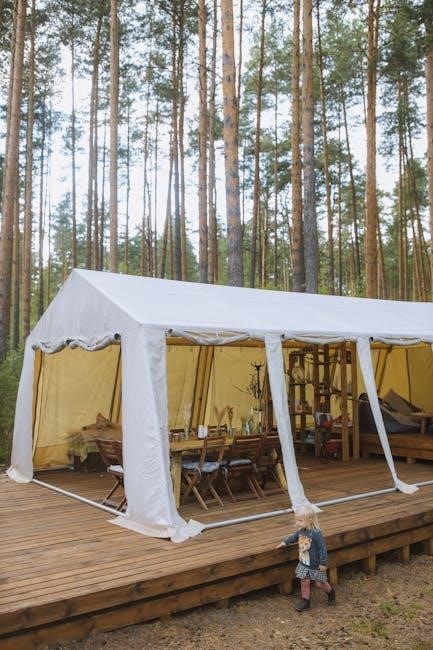Setting up canopy tents requires following specific instructions to ensure stability and safety, using
correct techniques
and equipment for successful installation always matters online.
Understanding the Importance of Proper Setup
Proper setup of canopy tents is crucial for ensuring the stability and safety of the structure. A well-set-up tent can provide a secure and comfortable shelter for users, while a poorly set-up tent can be hazardous and even dangerous; The importance of proper setup cannot be overstated, as it can make all the difference in the success of an outdoor event or gathering. By following the correct procedures and techniques, users can ensure that their canopy tent is set up correctly and safely. This includes carefully reading and following the instructions provided, using the correct tools and equipment, and taking the time to double-check the setup. With proper setup, users can enjoy their canopy tent with confidence, knowing that it is secure and stable. The benefits of proper setup are numerous, and it is an essential aspect of using a canopy tent. Proper setup is key to a successful and enjoyable experience.
Pre-Setup Preparation for Canopy Tents
Preparation involves checking equipment and
tools
for damage always before use online.
Gathering Necessary Tools and Equipment
To ensure a smooth setup process, it is essential to gather all the necessary tools and equipment, including the canopy tent frame, fabric, stakes, ropes, and any additional accessories.
The equipment should be in good condition, and all the parts should be accounted for to avoid any delays or complications during the setup process.
A thorough inspection of the equipment should be done before starting the setup process to identify any damaged or missing parts.
The necessary tools, such as a hammer, screwdriver, and pliers, should also be readily available to facilitate the setup process.
Having all the necessary tools and equipment will help to ensure that the setup process is completed efficiently and safely.
It is also important to refer to the manufacturer’s instructions for specific guidance on the required tools and equipment.
By gathering all the necessary tools and equipment, individuals can ensure a successful and stress-free setup process for their canopy tent.
The process of gathering equipment is crucial for the overall setup process, and it should be done carefully and thoroughly.

Step-by-Step Guide to Setting Up a Canopy Tent
Follow the instructions and use online resources for a successful setup of canopy tents always using correct techniques and equipment matters for safety.
Assembling the Frame and Attaching the Canopy
To begin assembling the frame, start by laying out all the poles and connectors, making sure to identify the different parts and their corresponding slots. Next, attach the legs to the corners of the frame, using the provided pins and clips to secure them in place. Once the legs are attached, stand the frame up and connect the roof poles, making sure they are securely locked into position. After the frame is fully assembled, it’s time to attach the canopy, starting with the corners and working your way around the frame, ensuring a tight and even fit. Use the provided straps and clips to secure the canopy to the frame, making sure it is tightly fastened to prevent any sagging or flapping in the wind. By following these steps, you should be able to successfully assemble the frame and attach the canopy, providing a sturdy and reliable shelter for your outdoor event. The frame and canopy should be assembled on a flat surface, free from any obstacles or debris.

Securing the Tent with Stakes and Ropes
Using stakes and ropes to secure the tent is crucial for stability and safety always matters online every time.
Ensuring Stability and Safety in Windy Conditions
To ensure stability and safety in windy conditions, it is essential to take extra precautions when setting up the canopy tent. This includes using heavier stakes and ropes to secure the tent to the ground, and making sure the tent is anchored firmly to prevent it from being lifted or toppled by strong winds. Additionally, it is crucial to monitor the weather forecast and be prepared to take down the tent if windy conditions are predicted. By taking these precautions, you can help ensure the safety of your guests and prevent damage to the tent. Using a spike and rope set can also provide added stability and security in windy conditions. It is also important to regularly inspect the tent and its components to ensure they are in good condition and can withstand windy conditions. This will help prevent accidents and ensure a successful event.

Troubleshooting Common Issues with Canopy Tents
Identify and resolve issues with canopy tents using online
resources
and guides for successful troubleshooting always.
Resolving Problems with Collapsed Frames and Tangled Fabric
When dealing with collapsed frames and tangled fabric, it is essential to approach the situation calmly and methodically. First, assess the damage and identify the cause of the collapse. Check for any bent or broken frame pieces and inspect the fabric for any tears or tangles. Next, gather the necessary tools and equipment, such as a mallet, wrench, and rope, to begin the repair process. Start by untangling the fabric and reattaching it to the frame, making sure it is securely fastened. Then, use the tools to straighten any bent frame pieces and reassemble the structure. If the damage is extensive, it may be necessary to replace certain parts or seek professional assistance. By following these steps and using online resources, such as instruction videos and PDF guides, you can successfully resolve problems with collapsed frames and tangled fabric, ensuring your canopy tent is safe and functional. Regular maintenance and inspection can also help prevent such issues from arising in the future.

and Final Check for Canopy Tent Setup
Upon completing the setup process, it is crucial to conduct a final check to ensure the canopy tent is stable and secure. This involves inspecting the frame, fabric, and anchoring system to guarantee everything is in place and functioning correctly. Verify that the tent is level, the fabric is taut, and the stakes are firmly secured to the ground. Additionally, check for any potential hazards, such as loose ropes or sharp edges, and address them accordingly. By performing this final check, you can have confidence in the safety and integrity of your canopy tent, providing a secure and enjoyable environment for your event or gathering. Using online resources, such as instruction videos and guides, can also help you troubleshoot any issues that may arise during the setup process, ensuring a successful and stress-free experience. Proper setup and maintenance are key to extending the lifespan of your canopy tent.

